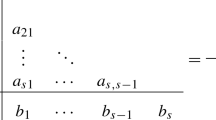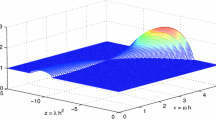Abstract
The general case of embedded (4, 5) pairs of explicit 7-stage Runge–Kutta methods with FSAL property (\(a_{7 j} = b_{ j}\), \(1 \le j \le 7\), \(c_7 = 1\)) is considered. Besides exceptional cases, the pairs form five 4-dimensional families. The pairs within two (already known) families satisfy the simplifying assumption \(\sum _j a_{ij}c_{j} = c_i^2 / 2\), \(i \ge 3\).



Similar content being viewed by others
Notes
It is natural and will be assumed that \(\sum _{j = 1}^{i - 1} a_{ij}= c_{ i}\). For \(i = 1\) the sum is empty, so \(c_1 = 0\) and \({{{\varvec{F}}}}_1 = {{{\varvec{f}}}} \bigl ( t, {{{\varvec{x}}}}(t) \bigr )\).
Usually the \({4}{\text {th}}\) order method vector of weights \({{{\varvec{b}}}} + {{{\varvec{d}}}}\) is written in place of \({{{\varvec{d}}}}\).
The FSAL property \(a_{7 j} = b_{ j}\), \(1 \le j \le 7\) and the order conditions \({{{\varvec{b}}}}^{\text {T}} {{{\varvec{c}}}} = 1 / 2\), \({{{\varvec{b}}}}^{\text {T}} {{{\varvec{c}}}}' = 1 / 6\), \({{{\varvec{b}}}}^{\text {T}} {{{\varvec{c}}}}'' = 1 / 24\) result in \(c'_7 = 1 / 2\), \(c''_7 = 1 / 6\), and \(c'''_7 = 1 / 24\).
The full analysis of \(a_{65} a_{54} a_{43} a_{32} = 0\) case is tedious and is not expected to result in an embedded pair of practical interest. For instance, if \(a_{32} = 0\), then \(c_3 = 3 c_2 / (8 c_2 - 3)\) and \(c_4 = 0\).
Further derivation was done in interaction with computer algebra system Wolfram Mathematica 8.0, mainly using commands Solve to symbolically solve linear equations, Simplify, and (in Sect. 3) Factor.
Also \(b_4 \mu _{4, *} + b_5 \mu _{5, *} + b_6 \mu _{6, *} = 0\), as \(b_4 = (1 / 24 - b_5 c''_5 - b_6 c''_6) / c''_4\).
In the case of an embedded pair of 6-stage Runge–Kutta methods, i.e., \(d_7 = 0\), the rank of the matrix \({{{\varvec{M}}}}\) without the \({5}{\text {th}}\) row should be equal to 1.
If instead of \(c'_3\) the variable \(g'_3 = c'_3 / c_3 (c_3 - c_2)\) is used, then the degrees are 6, 2, 3, 2, and 8.
References
Ascher, U.M., Petzold, L.R.: Computer methods for ordinary differential equations and differential-algebraic equations. SIAM (1998). https://doi.org/10.1137/1.9781611971392
Bogacki, P., Shampine, L.F.: An efficient Runge–Kutta \((4, 5)\) pair. Comput. Math. Appl. 32(6), 15–28 (1996). https://doi.org/10.1016/0898-1221(96)00141-1
Butcher, J.C.: On Runge–Kutta processes of high order. J. Aust. Math. Soc. 4(2), 179–194 (1964). https://doi.org/10.1017/S1446788700023387
Butcher, J.C.: Numerical Methods for Ordinary Differential Equations, 3rd edn. John Wiley & Sons Ltd, New York (2016). https://doi.org/10.1002/9781119121534
Butcher, J.C.: B-series: Algebraic Analysis of Numerical Methods. Springer, Berlin (2021). https://doi.org/10.1007/978-3-030-70956-3
Butcher, J.C., Wanner, G.: Runge–Kutta methods: some historical notes. Appl. Numer. Math. 22(1–3), 113–151 (1996). https://doi.org/10.1016/S0168-9274(96)00048-7
Cash, J.R., Karp, A.H.: A variable order Runge–Kutta method for initial value problems with rapidly varying right-hand sides. ACM Trans. Math. Softw. 16(3), 201–222 (1990). https://doi.org/10.1145/79505.79507
Cassity, C.R.: Solution of the fifth-order Runge–Kutta equations. SIAM J. Numer. Anal. 3(4), 598–606 (1966). https://doi.org/10.1137/0703052
Cassity, C.R.: The complete solution of the fifth order Runge–Kutta equations. SIAM J. Numer. Anal. 6(3), 432–436 (1969). https://doi.org/10.1137/0706038
Dormand, J.R., Prince, P.J.: New Runge–Kutta algorithms for numerical simulation in dynamical astronomy. Celest. Mech. 18(3), 223–232 (1978). https://doi.org/10.1007/BF01230162
Dormand, J.R., Prince, P.J.: A family of embedded Runge–Kutta formulae. J. Comput. Appl. Math. 6(1), 19–26 (1980). https://doi.org/10.1016/0771-050X(80)90013-3
Fehlberg, E.: Low-order classical Runge–Kutta formulas with stepsize control and their application to some heat transfer problems, NASA Technical Report R-315 (1969)
Fehlberg, E.: Klassische Runge–Kutta–Formeln vierter und niedrigerer Ordnung mit Schrittweiten-Kontrolle und ihre Anwendung auf Wärmeleitungsprobleme. Computing 6, 61–71 (1970). https://doi.org/10.1007/BF02241732
Hairer, E., Nørsett, S.P.: Solving Ordinary Differential Equations I: Nonstiff Problems, 2nd edn. Springer, Berlin (1993). https://doi.org/10.1007/978-3-540-78862-1
Hull, T.E., Enright, W.H., Fellen, B.M., Sedgwick, A.E.: Comparing numerical methods for ordinary differential equations. SIAM J. Numer. Anal. 9(4), 603–637 (1972). https://doi.org/10.1137/0709052
Iserles, A.: A First Course in the Numerical Analysis of Differential Equations, 2nd edn. Cambridge University Press, Cambridge (2008). https://doi.org/10.1017/CBO9780511995569
Lawson, J.D.: An order five Runge–Kutta process with extended region of stability. SIAM J. Numer. Anal. 3(4), 593–597 (1966). https://doi.org/10.1137/0703051
Owren, B., Zennaro, M.: Derivation of efficient, continuous, explicit Runge–Kutta methods. SIAM J. Sci. Stat. Comput. 13(6), 1488–1501 (1992). https://doi.org/10.1137/0913084
Papakostas, S.N., Papageorgiou, G.: A family of fifth-order Runge–Kutta pairs. Math. Comput. 65(215), 1165–1181 (1996). https://doi.org/10.1090/S0025-5718-96-00718-1
Sharp, P.W., Smart, E.: Explicit Runge–Kutta pairs with one more derivative evaluation than the minimum. SIAM J. Sci. Comput. 14(2), 338–348 (1993). https://doi.org/10.1137/0914021
Tsitouras, Ch.: Runge–Kutta pairs of order 5(4) satisfying only the first column simplifying assumption. Comput. Math. Appl. 62(2), 770–775 (2011). https://doi.org/10.1016/j.camwa.2011.06.002
Verner, J.H.: Explicit Runge–Kutta methods with estimates of the local truncation error. SIAM J. Numer. Anal. 15(4), 772–790 (1978). https://doi.org/10.1137/0715051
Verner, J.H.: Explicit Runge–Kutta pairs with lower stage-order. Numer. Algorithms 65(3), 555–577 (2014). https://doi.org/10.1007/s11075-013-9783-y
Acknowledgements
The author is grateful to anonymous reviewers for helpful comments and suggestions.
Author information
Authors and Affiliations
Corresponding author
Ethics declarations
Conflict of interest
Not applicable.
Additional information
Publisher's Note
Springer Nature remains neutral with regard to jurisdictional claims in published maps and institutional affiliations.
Appendices
Formulas for pairs of type A
Note that \({{{\varvec{c}}}}'\), \({{{\varvec{c}}}}''\), \({{{\varvec{c}}}}'''\), and \(b_6\) do not depend on \(c_2\). As \(b_2 = d_2 = 0\), the whole vectors \({{{\varvec{b}}}}\) and \({{{\varvec{d}}}}\) do not depend on \(c_2\). The coefficients \(a_{ij}\) and the weights \(b_j\), \(d_j\) are obtained using formulas in the beginning of Section 1, e.g., \(b_5 = (1 / 120 - b_6 c'''_6) / c'''_5\).
Formulas for pairs of type B
Formulas for pairs of type B\({}'\), \(c_3 = 0\)
Formulas for pairs of type B\({}'\), \(c_3 = c_2\)
See Appendix C for the expressions for p, q, \(c'''_5\), \(c'''_6\), and \(b_6 a_{65} c'''_5\). The whole vector \({{{\varvec{b}}}}\) depends on \(c_5\) only.
Rights and permissions
Springer Nature or its licensor (e.g. a society or other partner) holds exclusive rights to this article under a publishing agreement with the author(s) or other rightsholder(s); author self-archiving of the accepted manuscript version of this article is solely governed by the terms of such publishing agreement and applicable law.
About this article
Cite this article
Stepanov, M. Embedded (4, 5) pairs of explicit 7-stage Runge–Kutta methods with FSAL property. Calcolo 59, 41 (2022). https://doi.org/10.1007/s10092-022-00486-1
Received:
Revised:
Accepted:
Published:
DOI: https://doi.org/10.1007/s10092-022-00486-1




